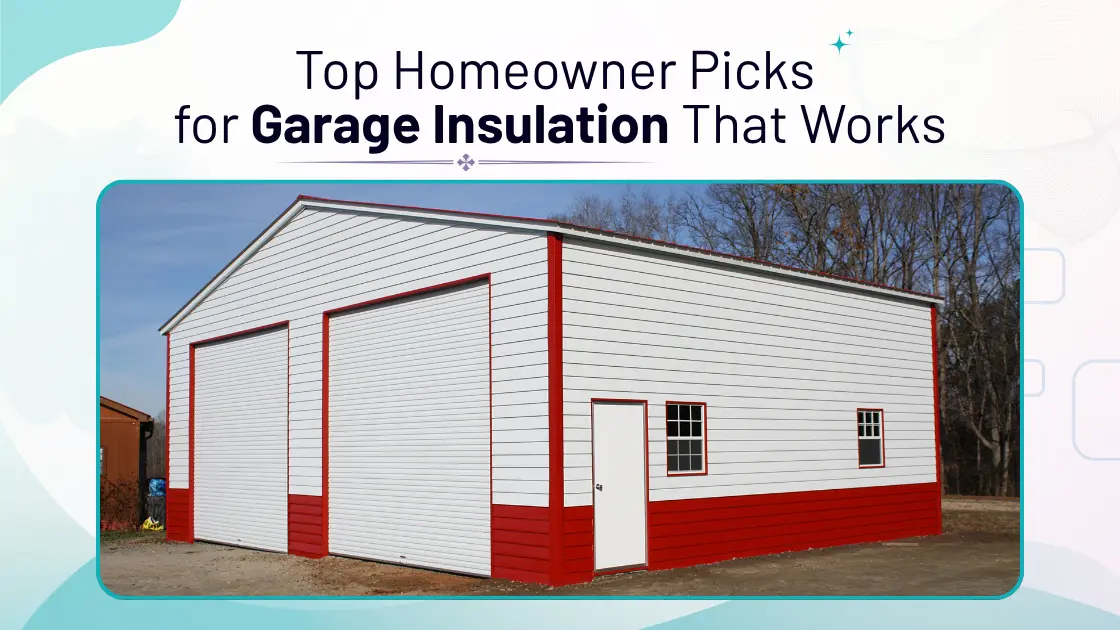
- November 4, 2025
Your garage is your workshop, gym, storage zone, and parking. Without insulation, it turns into an oven in summer and a freezer in winter. The temperature swing can spike your energy bills and damage tools, gear, or stored items. But when you insulate your custom metal garage, it helps in temperature control, moisture protection, and energy savings.
It makes the space more comfortable and usable throughout the year. Here, we will break down the best insulation types, their costs, R-values, and how well they block heat, and what works best for different climates.
5 Common Metal Garage Insulation Options
Although there are multiple types of insulations, like batts & rolls, concrete block, foam board/ rigid foam, ICFs, loose-fill & blown-in, reflective, SIPs, etc., here, we will focus on ones that suit metal prefab garages the best:
1. Fiberglass Batt & Mineral Wool Insulation:
What Is It? It’s a soft, fluffy insulation in rolls or panel form, which you can easily spot in your local hardware shop. It is made using recycled glass (cullet), sand (silica), and binders that trap heat effectively.
Pros: The benefits of fiberglass insulators are-
- Budget friendly
- Fire-resistant
- Reduces noise transmission
- DIY-ready
- Versatile use
- Widely available
Cons: Some downsides of fiberglass insulators are-
- Needs a vapor barrier
- Can absorb moisture
- Can gets messy during installation
- Can sag over time
R-Value: Around R-3.1 to R-3.7 per inch.
Cost: About $1.50 per sq. ft.
Best For: Frame walls and ceilings. It can fit snugly between wall studs and ceiling joists.
Sustainability: Fiberglass is made using recycled glass.
3. Foam Board Insulation:
What Is It? It’s a rigid, lightweight panel made from various plastic polymer materials like expanded polystyrene (EPS), extruded polystyrene (XPS), or polyisocyanurate (polyiso). It’s known for high R-values for metal workshop garages and comes in large, self-supporting sheets.
Pros: The benefits of rigid foam board insulators are-
- High R-value
- Moisture-resistant
- Space-saving
- Durability
- Easy to install
- Allows versatile application
Cons: Cons of rigid foam board insulation are-
- Costs more
- Needs careful cutting to fit
- Not fire-resistant & can release toxic fumes
R-Value: R-3.8 to R-7.9 per inch.
Cost: Around $0.70 to $1.20 per sq. ft.
Best For: Garage walls, ceilings, and doors. It is best for tight spaces and flat surfaces.
Sustainability: Rigid foam boards are made using petroleum products, which raises concerns about their environmental impact. However, some brands may offer low-VOC options, so check them out.
2. Spray Foam Insulation:
What Is It? It’s a plastic-based product that’s liquid foam, which is mixed on-site and sprayed into place where it expands and hardens to seal every crack. It is made of Isocyanate and Polyol Resin, which expands when mixed with a catalyst (like water or HFCs).
Spray foam is of two types – open cell (soft, lightweight, and flexible) and closed cell (denser, rigid, and higher R-value).
Pros: Advantages of spray foam insulation are-
- Airtight
- Moisture and mold resistant
- Noise reduction
- Better indoor air quality
- Higher efficiency
- Durability with long-term savings
Cons: Disadvantages of spray foam insulation are-
- Costs more
- Needs a pro to install
- Health risk
- Difficult to remove
R-Value:
- Open-cell – R-3.5 to R-3.8 per inch.
- Closed-cell – R-6 to R-7 per inch.
Cost: About $1 to $3.50 per sq. ft.
Best For: Full coverage and tricky shapes. It works on walls, ceilings, and the roof.
Sustainability: It helps in reducing energy bills, especially with closed-cell spray insulators.
4. Reflective Foil Insulation:
What Is It? It consists of a highly reflective surface, made of aluminum foil or a metalized film, Kraft paper, polyethylene bubbles, woven fabric, and foam core. Reflective foil is designed to combat radiant heat and trap air in the gap/ bubble to reduce heat transfer.
Pros: Benefits of reflective foil for a 2-car garage are-
- Lightweight
- Mold-resistant
- Great for hot climates
- Easy to install
- Cost-effective
- Durable
Cons: Downsides of reflective foil for the garage are-
- Lower R-value
- Needs an air gap to work well
- Ineffective in colder climates
- Potential electric hazard
R-Value: Around R-3 to R-17, depending on setup.
Cost: About $0.50 to $1.00 per sq. ft.
Best For: Roof panels and garage doors in sunny areas. It is often used on ceilings to reflect radiant heat.
Sustainability: Aluminum foil is recyclable.
5. Blown-In Insulation:
What Is It? Also known as loose-fill insulation, it is a type of thermal insulation that’s made of small, fluffy particles of material. It is blown into place using a machine through a hose into building cavities. It can be made of cellulose, fiberglass, and mineral wool.
Pros: The blown-in/ loose-fill insulation benefits are-
- Fills gaps easily
- Works great in attic spaces
- Energy-efficient
- Soundproofing
- Uniform coverage
Cons: Downsides of loose-fill/blown-in insulation are-
- Can settle over time
- Needs containment barriers
- Moisture absorption
- Messy installation process
- Weight concerns
- Fire hazard
R-Value: Around R-2.2 to R-3.8 per inch.
Cost: About $1.00 to $2.80 per sq. ft.
Best For: Ceilings with attic access or enclosed wall cavities. It is commonly used in places that are hard to reach.
Sustainability: Cellulose and recycled paper can be reused, making them an eco-choice.
Cost Breakdown Of Steel Garage Insulation
- DIY Cost – If you are installing insulation by yourself, you only need to spend on the material cost. For a metal 2 car garage, fiberglass batt or foam boards might cost a few hundred dollars, making it ideal for people who enjoy hands-on projects.
- Professional Installation Cost – Hiring a pro means paying for both labor and materials. So, on average, it can cost $2000 to $6000 for most homeowners. For example, a 2-car garage insulation can cost about $4500.
This includes expert fitting, sealing, and cleanup, and is best suited for those who don’t want to spend time on a massive DIY project.
Some Steps You Must Not Overlook When Insulating A Garage
Air Sealing:
Before rushing to insulate your metal garage, you must know that insulation will work only when air stays out. So, use low-expanding spray foam around windows, doors, and seams, and don’t forget to add weatherstripping to the garage’s door and frames to block drafts.
Energy Efficiency:
A well-insulated steel garage can cut energy bills by 10 to 20% per year. But which insulation should you choose? In hot and humid states like Texas or Arizona, reflective foil insulation helps bounce heat away. But, if you want top thermal performance, you can choose spray foam or foam board.
Note: The U.S. Department of Energy generally recommends R-13 to R-19 insulation for garage walls, but it can vary depending on your climate zone.
Insulation Application Tips For DIYers & Mistakes To Avoid
Smart Tips For DIY Success – Measure your steel garage’s walls, ceiling, and doors before buying insulation material. When applying, always wear PPE, like gloves & masks, then begin by sealing all the gaps and lastly install insulation.
Tip: In humid areas, consider adding a vapor barrier to avoid moisture damage.
Common Mistakes To Avoid – Don’t skip air sealing, since it can ruin your insulation’s effectiveness, and don’t ignore the garage door, as it is one of the biggest sources of heat loss. Make sure to choose the right insulation that matches your local climate for the best results.
Comfort, Savings, And Strength, Insulate Your Garage Like A Pro
Your insulation should match your climate, budget, and garage use. So, if you are planning to heat or cool the garage, go for a high R-value option like spray foam or rigid board. But, if it is just for storage, reflective foil or batt insulation might be enough.
Good insulation means you will get lower energy bills, less wear on your HVAC, and better protection for your stuff. So, whether you are in a snowy state or a sunny one, the right steel prefab garage insulation makes your garage stronger, safer, and smarter.


